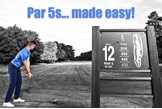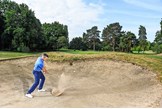How to score better on par 5s
Published: Last updated:
Improve your performance on golf’s longest holes with our comprehensive shot-by-shot guide to play better on par 5s, in association with Callaway.
Anyone who watches a lot of profefesional tour golf could be forgiven for thinking par 5s represent the easy holes in golf. Callaway’s Tour staff routinely make their score on these holes over the course of a tournament, with birdies plentiful and eagle attempts by no means a rarity for the likes of Henrik Stenson, Danny Willett, Matt Wallace and Xander Schaffele.
RELATED: How to cope when your form deserts you
However, cross over to the real world and the stats tell a different story. According to data collection experts Shot Scope, the average par 5 score across all handicap ranges is nearly 5.5 – a figure that gets worse as the handicap gets higher.
Clearly, for the club player, par 5 holes are no pushovers. But in covering the five most common shots we face on par 5s, this guide will help you turn a potential weakness into a strength. As you work through them, chart your own stats so you can monitor your improvement.
RELATED: Which Callaway iron is right for me?
1. The Par-5 Tee Shot

For the average club golfer, the difference between an average drive and their best drive is a massive 24 yards. If you can get closer to your best more often, you will massively increase your chances of hitting a par 5 green in three… and quite possibly two. To boost your driver power, focus on your hips…
A full backswing turn creates and stores power. In trying to create a full turn, most club golfers think about their shoulder rotation. However, unless you are extremely fit and flexible, your shoulder rotation is governed and limited by your hip turn.
RELATED: Five simple steps to lower golf scores
It’s the hips – not the shoulders – that lay down the foundation for your backswing turn.
A full and free hip turn creates freedom through your core and gives your shoulders the chance to turn through 90 degrees, or even a little more. That fuller coil allows you to generate more speed and power on the way down.
RELATED: How does Callaway’s Epic rank among the best drivers?
To watch in full screen on desktop press play and click the YouTube icon
2. The Fairway Wood

For most of us, even our Sunday-best tee shot will leave us with 250 or more yards to the green. This gives us a choice for a second shot – an aggressive crack at the green with a fairway wood, or a more safety-first lay-up. But with the stats suggesting the more aggressive option will reap rewards, the ability to strike a solid fairway wood becomes important.
RELATED: How does Callaway’s Epic rank among the best fairway woods?
Your focus with these low-lofted woods is attack angle. While the teed-up driver allows an upward blow and a lofted iron works best with a slightly downward one, the fairway wood demands a level attack and a feeling of hitting the ball forwards. Use set-up and swing to promote this…
To watch in full screen on desktop press play and click the YouTube icon
3. The Lay-Up

RELATED: Four Callaway irons among our Best of 2020
Of course, there are times when going for the green in two makes no sense – usually because of water or other penal hazard placement around the green. Here, your only option is to lay up. Here’s how to hit the perfect lay-up shot.
To watch in full screen on desktop press play and click the YouTube icon
4. Pitching it close

With most par 5s out of reach in two for most of us, our third shot is typically a pitch shot.
From this range, most of us can hit the ball fairly straight. Controlling distance, though, is another matter.
RELATED: Mark Crossfield fixes your short game
These tips will help you refine your action into one that doesn’t so much develop power as contain it.
5. The Long Bunker Shot

It is a favourite trick of course designers to build bunkers 40 or 50 yards short of par-5 greens. These traps serve the dual purpose of visually foreshortening the approach, while adding extra protection against anyone striking out for the green in two.
RELATED: Callaway’s Francesco Molinari shares his strategy tips
Knowing you can cope with the longer sand shot can give you the confidence to play a bold second shot. Follow this plan…
READ NEXT: Tested: Callaway Chrome Soft vs Titleist Pro V1 golf balls
-
 Score better on par 5s with our complete guide.
Score better on par 5s with our complete guide.
-
 A fairway wood off the deck causes many golfers problems, but it doesn't need to...
A fairway wood off the deck causes many golfers problems, but it doesn't need to...
-
 Setting a 'fine' for certain hazards on the golf course
Setting a 'fine' for certain hazards on the golf course
-
 A great tee shot is the key to scoring well on a par 5
A great tee shot is the key to scoring well on a par 5
-
 Hit the perfect lay-up shot and you can still make birdie on a par 5.
Hit the perfect lay-up shot and you can still make birdie on a par 5.
-
 Hit your pitch shot close and give yourself a chance for birdie.
Hit your pitch shot close and give yourself a chance for birdie.
-
 Making a full turn is key to powerful drives
Making a full turn is key to powerful drives
